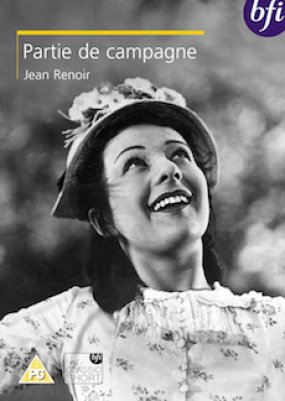
When Partie de campagne (A Day in the Country) was finally released in 1946, ten years after it was shot, it was hailed as an ‘unfinished masterpiece’. Since then, Jean Renoir’s masterly adaptation of a short story by Guy de Maupassant, running at just under 40 minutes, has grown in reputation to the point where it has become one of his best-loved films.
On an idyllic country picnic, a young girl leaves her family and fiancé for a while, and succumbs to an all-too-brief romance. Shot on location on the banks of two small tributaries of the Seine, Renoir’s sensuous tribute to the countryside – and to the river – has seldom been surpassed. Water, and the movement of rivers in particular, flows like a constant theme through Renoir’s films but nowhere in all his work is the river more central to the action than in Partie de campagne.
Author Guy de Maupassant was a friend of Renoir’s father, the Impressionist painter Auguste Renoir. The film sticks closely to his original story, although the tone is altered and the characters are expanded. The main change – imposed on the filmmakers by the disastrous weather during the course of the shoot – is that the story is set during a searing heatwave, while the film’s events take place on a fickle day where brief bursts of sunshine give way to clouds and finally to a downpour.
The film was originally intended to run some 50 minutes. However, shooting was constantly delayed by the rain and eventually Renoir quit the production to start his next film. The producer, Pierre Braunberger, was left with the incomplete footage. He considered turning the film into a full-length feature, and commissioned an expanded script, but Renoir refused to have anything to do with it. Not until after the war was Braunberger able to turn the film into a viable release, when it was reconstructed with two intertitles to replace the missing scenes, and a score was commissioned from Joseph Kosma.
Special features
- Commentary by film historian Philip Kemp.
- Additional material from the Cinémathèque Française, including discarded takes and silent screen tests.
- Biography of Jean Renoir.
Product information
-
-
Certificate
PG
-
Colour
Black/white
-
Sound
Sound
-
Running time
39mins
-
Languages
French
-
Subtitles
English
-
Original aspect ratio
1.33:1
-
DVD region
2 Europe (except Russia, Ukraine, and Belarus), Middle East, Egypt, Japan, South Africa, Swaziland, Lesotho, Greenland, French Overseas departments and territories
-
Catalogue number
BFIVD576
-







